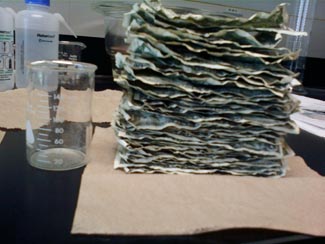Two University of Alabama at Birmingham students have found traces of methamphetamine on U.S. currency in Birmingham, the first time meth has been identified on $1 bills since a UAB Department of Justice Sciences laboratory began testing currency in 2008. The findings, part of a broader UAB study to determine if it is possible to track the spread of meth through a region, are set to be published in the U.S. Drug Enforcement Administration’s Microgram Journal later this year.
 Jessi Mann, a UAB senior participating in the National Science Foundation’s Research Experience for Undergraduates (REU) program, worked with Brandon Fultz, a senior chemistry major, to test a total of four sets of 20 $1 bills from Jefferson County. Two sets came from a home-improvement store in the northern part of the county, one set from a fast-food restaurant in downtown Birmingham and the last from a home-improvement store in the western part of the county. The highest instance of meth contamination, 17 of 20 bills, was found on the bills from the home-improvement store in north Jefferson County. The lowest instance of contamination, two of 20 bills, was found in downtown Birmingham.
Jessi Mann, a UAB senior participating in the National Science Foundation’s Research Experience for Undergraduates (REU) program, worked with Brandon Fultz, a senior chemistry major, to test a total of four sets of 20 $1 bills from Jefferson County. Two sets came from a home-improvement store in the northern part of the county, one set from a fast-food restaurant in downtown Birmingham and the last from a home-improvement store in the western part of the county. The highest instance of meth contamination, 17 of 20 bills, was found on the bills from the home-improvement store in north Jefferson County. The lowest instance of contamination, two of 20 bills, was found in downtown Birmingham.
“Methamphetamine was something UAB had never seen before over the years of testing U.S. currency, so we went back through all the previous research to see if it had been there before and maybe we had not noticed, but none of our previous research had any methamphetamine contamination,” says Fultz, who worked under Elizabeth Gardner, Ph.D., a justice sciences assistant professor.
In 2009 UAB students found as much as 65 percent of $1 bills in Birmingham had traces of cocaine. Read the story.
The 2011 REU class worked on identifying the next new “legal highs.” Watch the story
| The National Science Foundation's Research Experience for Undergraduates program's 2011 class worked on identifying the next new “legal highs.” Watch the story. |
The students’ discovery is “not surprising at all,” says Randy Christian, chief deputy in the Jefferson County Alabama Sheriff’s Office. “It seems to mirror the arrests made. The majority of meth-related arrests seem to occur in northern and western Jefferson County, while central and southern parts see fewer of these types of arrests. Meth possession appears to be more prevalent in more rural parts of the county. This is likely due to the secrecy involved in the manufacturing process and the demographics of the users.”
The National Institute on Drug Abuse, a division of the National Institutes of Health, says meth is a very addictive stimulant that is toxic to the central nervous system. The National Substance Abuse Index, a website that provides resources for battling addiction, says “meth is becoming the biggest drug threat in Alabama.”
Christian would not go that far in his assessment of the problem. He says meth arrests have remained fairly consistent since 2008, despite raised awareness.
“The increased exposure is probably due to the increased portability of meth labs,” Christian says. “The latest manufacturing method allows meth to be made in something as small as a 20-ounce soda bottle. These ‘one-pot’ labs began to rise in prevalence in late 2007. The proliferation and easy portability make it more likely that items including people, clothing and currency will be exposed.”
Fultz, Mann and Gardner originally hypothesized that the contamination came straight from the meth. However, Gardner now has a different theory as to how it happens.
“We see caffeine on currency all the time, and I doubt the bills are exposed to so much coffee, tea and soda that they are the source of contamination,” Gardner says. “I think the contamination on currency is coming from sweat.”
For now it is just a theory. But it’s a theory that will ultimately lead to more sweat — at least in the lab. And that is okay with Gardner and her protégés, because science is about discovery.
“We are on a fact-finding mission more than we are out there to prove our own hypothesis,” says Fultz. “Sometimes you hope for positives, but at the same time, you hope for negatives because a story is told either way.”
UAB’s crime REU is highly competitive, with 218 students applying and only 12 selected. The eight-week program is made possible through a National Science Foundation REU grant to the UAB Department of Justice Sciences. Kent Kerley, Ph.D., is the primary investigator.
More information about the UAB crime REU program can be found online.